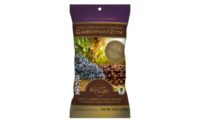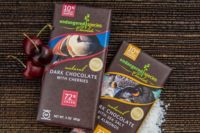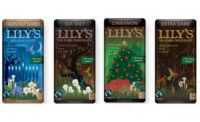Dark Chocolate
Now that the ‘chocolate bar’ has been raised towards more premium varieties, retailers need to strategize to capture an even higher-impulse chocolate market.
Overview
C’mon, tell us your deepest, darkest, candy
desires — and chances are, they’ll be covered in dark
chocolate.
Because of “evolving” consumer tastes,
there’s not a chocolate maker around that hasn’t seriously
thought about — and more than likely, now gone the route of —
the dark side, at least to some degree. It seems the more bitter, the
better these days, thanks to refined palates and a flood of health news
surrounding chocolate with higher cacao/cocoa content and less sugar
content.
Making up about 11 percent of the total chocolate
market, dark chocolate is $510 million dollars strong, with sales growing
43 percent vs. a year ago, according to the latest 52-week information
supplied by ACNielsen.
A growing sub-set of the dark chocolate segment is the
emergence of origin and organic concepts.
Overlapping (or perhaps more accurately, enrobing)
dark chocolate with other popular consumables, such as savory snacks and
mints, is another hot spin-off, often creating products that are perceived
to be even more “gourmet” and commanding higher price points
than the “naked” versions of the products.
Target Audience
It used to be that more ethnic, affluent, and/or
European-traveling consumers were the best target for dark chocolate sales
in this country. Today, the mass appeal of gourmet coffee houses (often now
selling dark chocolates, by the way), as well as the rise in chocolate
cafes and the healthy hype surrounding dark chocolate, has contributed to
the desire for more “good quality daily chocolate breaks” from
adult consumers of all walks. And that means more dark chocolate for
everybody; the sensory experience of enjoying dark chocolate has become
powerfully and universally appealing.
That said, this is not a category to target to kids or
teens that typically do not have the palates for “candy” with
less sugar, more bitter flavors.
The ideal audience is still adults with refined
palates — and those used to savoring these not-so-guilty-anymore
pleasures. Chances are, too, that if you have wine connoisseurs or strong
coffee drinkers as your customers, you have built-in dark chocolate lovers
to target.
And let’s not forget about the female market
segment; dark chocolate manufacturers certainly have not. New packaging
reflects a feminine appeal, not only in colors, fonts, but in clever
sayings as well — such as those that play up the “PMS
relief” aspect of their “dark” food.
Pricing/Positioning
With dark chocolate perceived as more
“gourmet” chocolate (and often, the two categories overlap
greatly), it commands higher price points, even from those consumers who
are buying it through mainstream retail channels. Currently, dark chocolate
bar prices often start at $1 an ounce, but can easily exceed $1.50 or even
$2 an ounce.
Seasonal Opportunities
Sure, there are opportunities to sell more dark
chocolate on holidays, but that’s just because more people are
enjoying it all year long. Perhaps the best seasonal news about dark
chocolate is that it can be both a “Valentine’s Day
extravagance” and an “everyday indulgence.” This means
that consumers will pick up a box of dark chocolates for a loved one on
Valentine’s Day, Easter, Mother’s Day, etc., and be
simultaneously reminded to buy a bar or bag, or both, of dark chocolate for
their own consumption during the week. Dark chocolate, it is predicted,
begets dark chocolate. Therefore, cross-merchandising
“everyday” dark chocolate with “seasonal”
selections is a natural opportunity.
Outlook
Moving forward, expect to “see the dark”
from all chocolate manufacturers, no matter how mainstream. Those already
in it will aim for even “higher” dark places. Cocoa
connoisseurs are emphatic that the industry will continue to see the rise
of single-estate and varietal chocolate; the most discerning consumers will
search for cacaos of different continents, countries, regions within
countries and even farms within a region.
The word is that the industry can expect to see more
chocolate actually made where the cacao is grown; right now these
bean-to-bar chocolate makers are primarily in Europe and the United States,
but Venezuela and Ecuador are catching on quickly.
Another trend — “hot” chocolate will
become literal. While the Mexicans have laced their chocolate with spices
for centuries, American consumers’ taste for more sophisticated
chocolate has led to the up-and-coming coupling of darker chocolate
(starting in specialty, but migrating to the masses) with spicier, more
savory, ethnic flavorings, such as: all kinds of pepper, including black
and cayenne; ancho chiles; lemon and lime; intense cinnamon; ginger;
paprika; pine nuts; cloves; sea salt; rosemary, and even sun-dried
tomatoes.
An additional dark treat on the horizon —
“rustic” chocolate bars, which will allow consumers to crunch
into cocoa nibs and sugar crystals.
$510
million
Dark Chocolate Estimated U.S. Retail Market Size
Source: ACNielsen
Dark Chocolate Estimated U.S. Retail Market Size
Source: ACNielsen
Merchandising Musts
• Shine the light on a dark place. Dark chocolate definitely deserves its own special place in
the candy planogram these days. The latest category success has reportedly
been generated by merchandising all of the dark products in a dedicated
dark chocolate section — and perhaps providing accompanying
explanation graphics, such as those that some bar suppliers now offer.
• Make healthy hints. Knowing
that consumers recognize the health benefits of dark chocolate,
cross-merchandising it with other products rich in anti-oxidants, such as
wine, or even colorful fruits like berries, is a wise idea. Keep in mind,
though, that most chocolate manufacturers will not make any health claims
for their dark products, and neither should retailers. In this instance, it
is best to let consumers make their own health conclusions/purchase with
their own health perceptions. But it certainly doesn’t hurt to
merchandise logical (and attractive) pairings.
• Let them trade up. The
dark chocolate cocoa content has turned into a numbers game, and retailers
should be prepared to let consumers “trade up” as their taste
buds become more refined/less inclined to want a sugary taste. Planograms
should include bars with lower, more “beginner” cocoa content
(such as 60, meaning that about 40 percent of the bar is made up of sugar),
then middle-ground bars with about 70-72 percent cocoa, and finally, have
those that are for the “most serious” dark chocolate lovers,
some at 85 percent or 92 percent. In fact, at least one manufacturer now
offers a 99 percent “killer” cocoa bar in its portfolio.



